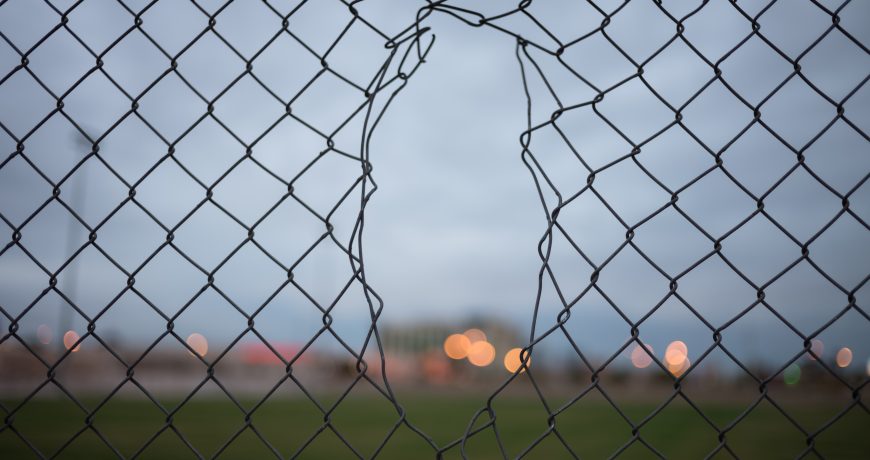Who is Responsible for Fence Repair in Texas?
Fences play a crucial role in defining property boundaries, enhancing security, and giving you some privacy from your neighbors and those passing by on the street in front of your home.
However, the inevitable wear and tear that comes with time, as well as the occasional damage from extreme weather conditions, can raise important questions about responsibility when it comes to fence repair in the Lone Star State.
So, who is responsible for fence repair in Texas, exactly? If you share a fence with your neighbor, what’s the best course of action to take when it’s time for a repair job?
In this article, we’ll discuss fence maintenance and repair, exploring the rights, obligations, and legal aspects that govern this common issue for Texas homeowners. We’ll also show you the best place to get zero-fuss, professional fence repairs in Texas that won’t break the bank!
Who is Responsible for Fence Repair in Texas?
So, who is responsible for fence repair in Texas? When it comes to fence repair in the state of Texas, clarity is essential to prevent disputes and misunderstandings among property owners.
Understanding the responsibilities and legal framework surrounding fence maintenance is crucial. Let’s explore who is responsible for fence repair in Texas, and the laws surrounding Texas fences.
Understanding Texas Property Law: Setting the Foundation
In Texas, property law is based on the principle of “self-help”. This means that property owners are generally responsible for maintaining their own property, including fences, and resolving any related issues.
Texas law does not impose an automatic obligation on property owners to share the cost of building or repairing a fence unless there is a written agreement specifying such an arrangement.
Shared Boundaries and Co-ownership: When the Fence Sits on the Line
In cases where a fence sits directly on the property line, Texas law typically considers it a “boundary fence”. When two neighboring property owners share a boundary fence, they are often referred to as “co-owners” of the fence.
Both co-owners are responsible for the maintenance and repair costs of the boundary fence, provided there is a written agreement outlining the division of expenses. If there is no written agreement, the default rule is that each co-owner is responsible for an equal share of the costs.
Single Ownership Fences: When It’s Clearly on One Property
When a fence is entirely located on one property, it is considered the sole responsibility of that property owner. That owner is responsible for the construction, maintenance, and repair of the fence without any obligation for cost-sharing with neighbors.
What If There’s No Written Agreement? The Grey Areas
One of the common challenges arises when there is no written agreement between neighbors regarding fence maintenance and repair. Who is responsible for fence repairs in Texas in these cases? Unfortunately, Texas law can be somewhat ambiguous.
Generally, if there is no agreement specifying otherwise, each property owner is responsible for the fence that primarily benefits their property. However, disputes can arise over what constitutes a “primary benefit”.
Courts may consider factors like which side of the fence faces which property, who installed the fence, and how long the fence has been in place. It’s best for neighbors to come to a mutual agreement regarding fence maintenance to avoid legal disputes – more on that next.
Neighborly Disputes and Communication Regarding Fence Repair in Texas
Neighborly disputes over fence repair unfortunately occur from time to time. Here are some tips on what to do if you ever find yourself in this situation.
Approaching the Conversation Diplomatically
Resolving fence repair issues should begin with a polite and diplomatic conversation between neighbors. Find a neutral setting for the discussion to ensure you are both comfortable. Listen to your neighbor’s concerns, as understanding their point of view can help you find common ground.
Keep your emotions in check and avoid accusations or confrontational language. Focus on finding a solution with your neighbor. Come to the conversation with potential solutions or compromises to discuss – a proactive approach can make it easier to find a resolution.
Documentation and Proof: When it’s Time to Back Your Claims
If things escalate, having documentation and evidence can be crucial. Collect any written agreements, property surveys, or other documents that relate to the fence. Document the condition of the fence and any damage. Timestamped photos can serve as valuable evidence.
Maintain a record of all interactions with your neighbor regarding the fence issue. This includes emails, texts, and letters. Consider getting an assessment from a fencing contractor or surveyor to provide an expert opinion on the condition and responsibility for the fence.
Legal Recourses: When Diplomacy Doesn’t Work
If diplomatic efforts fail to resolve the fence repair dispute, you may need to explore legal options. Mediation is a good place to start, as it involves a neutral third party who helps facilitate a resolution between neighbors and can be a cost-effective alternative to litigation.
For disputes involving relatively small amounts of money, you can file a case in small claims court. Each county in Texas has its own small claims court rules and limits. When the dispute involves the actual location of the property line, you may need a surveyor to determine the boundary.
As a last resort, you can file a lawsuit in district court. This can be a costly and time-consuming option, so it’s best to try everything else first. Consult with an attorney specializing in real estate or property law first, to understand your rights and responsibilities.
The Financial Aspect: Sharing Fence Repair Costs Costs and Avoiding Disputes
When it comes to fence repair, the financial aspect often raises issues between neighbors. Establishing clear guidelines for sharing expenses and considering cost-effective options can help prevent disputes – let’s take a closer look.
Drafting an Agreement for Shared Expenses
To avoid misunderstandings and conflicts, it’s a good idea for neighboring property owners to draft a written agreement outlining how they will share the costs of fence repair and maintenance.
In the agreement, clearly state who is responsible for what aspects of the fence, such as repair, replacement, or routine maintenance. Outline how the repair costs will be divided, whether equally, based on the length of the property bordering the fence, or another agreed-upon method.
Also, establish a process for resolving any disagreements that may arise during the repair or maintenance process. Consider including provisions for unexpected expenses or changes in ownership of the properties – the more scenarios you cover, the better.
The Role of Homeowner’s Insurance in Fence Repairs
Homeowner’s insurance policies may cover fence repairs in certain situations. Typically, if the fence was damaged due to an event like a storm or fire, the cost of repair or replacement may be covered.
Like all insurance policies, coverage can vary. Examine your homeowner’s insurance policy to understand the extent of coverage for fence repairs. Some policies may have specific limits or exclusions.
Also, consider the deductible you will need to pay before your insurance coverage kicks in, and assess how a claim may affect your future premiums. Contact your insurance provider promptly to initiate the claims process and understand your options for fence repair coverage.
Determining the Cost-Benefit of Repair vs Replacement
When faced with a damaged fence, property owners should assess whether repair or replacement is the most cost-effective option. Evaluate the severity of the damage. Minor issues may be easily repairable, while extensive damage may necessitate a full replacement.
An old and deteriorating fence may not be worth extensive repairs. Think about the long-term maintenance costs associated with an older fence – it may make financial sense to invest in a new, more durable fence rather than constantly repairing an old fence.
Tips on Repairing Your Fence Fast
Regardless of who is responsible for fence repair in Texas, sometimes the priority is simply getting your fence fixed as quickly as possible, especially if it’s compromising your yard’s security or your home’s safety. Here are some tips for safe, efficient fence repair.
Quick Fixes vs Long-term Solutions: Weighing Your Options
Quick fixes are temporary solutions, but may be suitable for minor damage or situations where a full repair or replacement is not feasible in the short term. Quick fixes may involve using tools like zip ties, brackets, or simple patches to secure loose boards or panels.
For more significant damage or when the fence is nearing the end of its lifespan, investing in a long-term repair or replacement is generally a better option. Long-term solutions often involve replacing damaged sections, reinforcing weak posts, or installing a new fence altogether.
The Importance of Using Quality Materials for Repairs
Whether you opt for a quick fix or a long-term solution, using quality materials is essential for a successful fence repair. Quality materials can withstand the elements and provide long-lasting results, preventing the need for frequent repairs in the future and saving you significant money.
High quality materials can also ensure that your repaired fence maintains its appearance, blending seamlessly with the rest of the structure. Plus, a well-maintained fence can contribute to the overall curb appeal of your property and positively impact your property’s value.
DIY vs Hiring Professionals: When to Call in the Experts
Who is responsible for fence repair in Texas? Should you do it yourself, or hire a professional? The answer depends on your skills, how complex the repair job is, and the tools required.
Simple and minor fence repairs, such as fixing loose boards or replacing a single panel, can often be handled by homeowners with basic DIY skills and tools. DIY can be cost-effective for small-scale projects that don’t have a real impact on the structure or safety of the fence.
For extensive damage, structural issues, or when dealing with specialized materials like wrought iron or vinyl, it’s often best to hire experienced fencing professionals. They have the expertise, equipment, and materials to ensure a thorough and lasting repair.
Reach Out to Viking Fence for a Simple, Seamless Fence Repair Process!
If you’re looking for fence repair in Austin, you’re in the right place. At Viking Fence, we have more than 50 years of experience in local fence replacement and repairs. Our team uses top-quality materials for all our Austin fencing projects, ensuring a repair job that stands the test of time.
We specialize in a wide variety of fences, including wrought iron vs aluminum fences, vinyl fencing in Austin, Austin chain link fence repairs, and even automatic gate repair in Austin. No job is too big or too small!
If you’re looking to install a new fence, we can take care of that too. We’ll help you choose the best material for your new fence, break down your options for you, and ensure the final product looks even better than you imagined.
Whether you’re wondering what chain link fences are made of or need some advice on how to install wrought iron fences, we’d be happy to share our experience and help you elevate your home’s safety, curb appeal, and value with the right fence for your needs.
Parting Thoughts on Who is Responsible for Fence Repair in Texas
So, who is responsible for fence repair in Texas? It’s often a murky combination of property law, neighborly agreements, and insurance policies. One thing that is clear is that Viking Fence is the best place to call when you’re in need of fast, reliable, fence repairs.
With five decades of unmatched experience and the best materials at our disposal, Viking Fence is your go-to fence repair company. Whether you’re looking for a new wrought iron fence in Austin, or access control in Austin, TX, the team at Viking Fence is ready to help.
Repair your fence quickly and safely with help from your local experts at Viking Fence!

